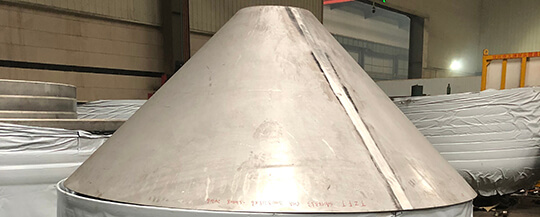According to the material and pressure grade of the long-distance pipeline, match the commonly used pressure vessel steel plate as the material for the pipe pressure test head, and determine the structure type and thickness of the head according to the pressure vessel method.
Symbol Description
δ —— calculated thickness, mm;
Pc —— calculated pressure, MPa; equal to the sum of the design pressure and the static pressure of the pressure test pipe section liquid level difference;
Di —— the inner diameter of the head, mm;
[σ] t —— allowable stress of material at design temperature, MPa;
φ —— Welding joint coefficient, using the whole sheet material to take 1;
α —— cone half apex angle, (°)
Pressure test is a key process of pipeline construction involving personal and property safety. In the pipeline design specifications and construction specifications, there is no corresponding regulation on the head type, material and thickness of the pipeline pressure test. The construction unit generally refers to the actual experience and material. The situation is certain, there is a greater security risk. But pressure pipes (maximum diameterφ1219mm, maximum design pressure 10MPa) and pressure vessels (maximum diameter exceeds φ5000mm, maximum design pressure greater than 100MPa)
They are all pressure-bearing special equipment. The pipeline is equivalent to a pressure vessel with a long cylinder. The pipeline pressure test is exactly the same as the pressure test of the pressure vessel. Therefore, the pressure vessel method is used to determine that the pressure test head of the long-distance pipeline is satisfactory Pipeline requirements. The head type, material and thickness of the pipeline pressure test can be determined according to the basic requirements and calculation methods of the pressure vessel.
1 Choice of head type
According to different geometric shapes, pressure vessel heads are generally divided into spherical heads, elliptical heads, dish heads, cone heads, flat caps, etc. Based on peak stress and abrupt changes in cross-section, spherical heads are preferred, followed by other heads. Flat heads have the worst stress conditions and the largest cross-sectional changes.
1.1 Spherical head
The cross-sectional shape of the spherical head is hemispherical. There is no corresponding professional manufacturing standard for the spherical head. So far, it is generally designed and calculated in accordance with GB150 and manufactured with reference to JB/T4746. According to the needs, the straight side of the head is optional. Determined by negotiation. Due to the smallest cross-section mutation, its stress condition is the best, and the metal thickness required under the same conditions is the smallest.
However, due to the large depth of the head, the processing difficulty is relatively large, and considering the factors of welding with the pipe (cylinder) and other thicknesses, from the perspective of economy and application, the spherical head is generally used in high pressure occasions to reflect its force Advantages of good condition and small thickness of materials. It is recommended that the pipes with design pressure≥8.0MPa use spherical heads as pressure test heads.
1.2 Standard Elliptical head
The cross-sectional shape of the elliptical head is semi-elliptical, which is designed and calculated according to GB150 and manufactured and processed according to JB/T4746. Its cross-section mutation and stress condition are second only to spherical heads, processing depth is small, and it is most commonly used.
It is recommended to use standard elliptical heads as pressure test heads for pipelines with a design pressure of <8.0MPa.
1.3 Dish head
Used less, not used.
1.4 Conical head
Conical heads are similar to the middle and small heads of pipe fittings, which are designed and calculated according to GB150 and manufactured and processed according to JB/T4746. Because the pipe diameter and the diameter of the pressure vessel often do not match, the tapered head is used as the transition section during the pressure test, so that the diameter of the tapered head matches the spherical head and the elliptical head. The length of the tapered head shall not be less than the outer diameter of the pipe and shall not be less than 0.5m.
The transition of tapered heads must be transitioned to the closest diameter value in the pressure vessel diameter series, and the pipe diameter should be transitioned from large to small.
1.5 Flat bottom head
There are many types of flat bottoms. In GB150, only the design calculations for unreinforced flat bottoms are specified, with a total of 13 types; in HG20582, there are more detailed regulations on the structure and thickness calculation of radially stiffened flat bottoms, but It is only suitable for low pressure vessels (<1.6MPa) and vacuum vessels. Although the stiffened round flat-bottomed head has been successfully used in pipeline pressure testing and is theoretically feasible, its thickness calculation is very complicated, and no literature data and applicable methods that can solve the thickness calculation well have been retrieved. According to experience to determine the structure and thickness, there are safety risks and uncertain factors. In terms of safety and applicability, further research is needed. Therefore, flat-bottomed heads are not recommended for pipeline pressure tests.
